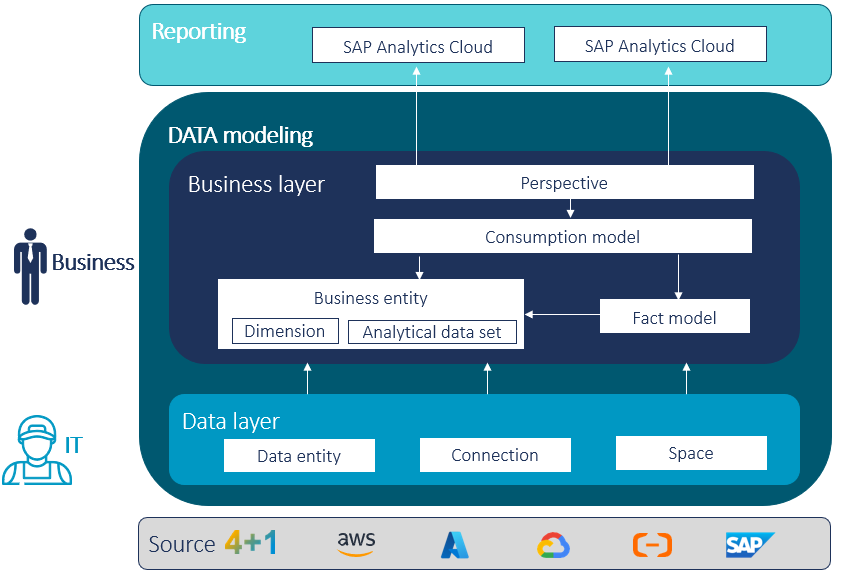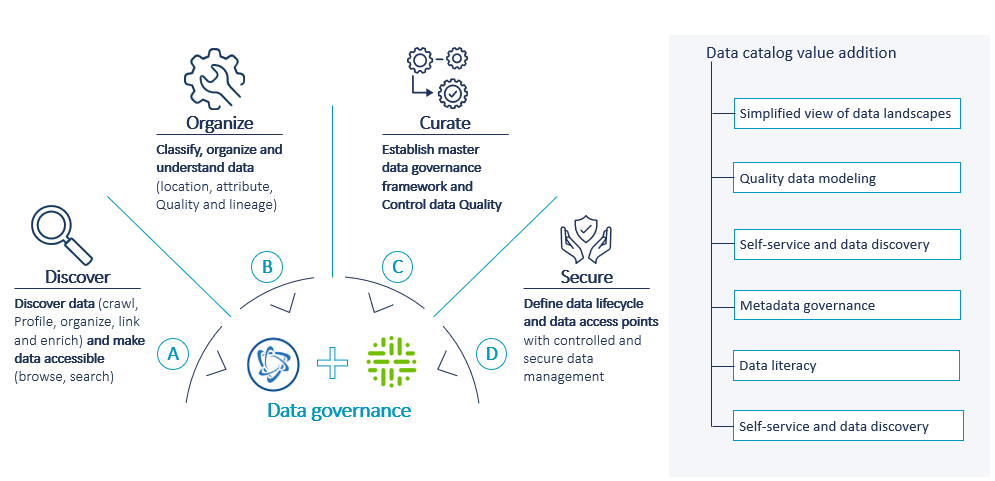Data is widely recognized as the engine that drives growth and innovation. To fully realize the potential of data and its sibling analytics, organizations must develop a secure data strategy that promotes a data culture and enables data monetization and data-driven innovation. This involves
- broadening access to data while maintaining security measures to protect sensitive information, and
- fostering a culture that values and prioritizes data-driven decision-making.
By doing so, organizations can unlock new opportunities and drive growth and innovation in their operations.
SAP Datasphere Leverages Potential of Data-Driven Innovation
SAP Datasphere empowers organizations to harness the full potential of their data by providing a secure, scalable, and intuitive platform for data-driven innovation. With SAP Datasphere, businesses can explore new possibilities for growth and innovation through advanced analytics, machine learning, and AI-driven insights. Whether it is optimizing operations, improving customer experience, or developing new products and services, SAP Datasphere provides the tools and expertise needed to unlock the full potential of data.

SAP Datasphere Key Features

Business Data Fabric
Together with SAP Datasphere, SAP launched new partnerships to complete the set-up of analytical data management and the idea of a Business Data Fabric (BDF). BDF is designed to support the increasing demand for data-driven decision-making, as it enables organizations to gain real-time insights into their data, regardless of its location. It leverages a variety of data integration technologies, including data virtualization, data integration, data quality, and data governance, to ensure that data is accessible, accurate, and consistent across the organization.
SAP has established partnerships with a diverse range of leading technology vendors to help organizations for their processes and reduce complexity. Following strategic partners brings the unique strengths to build a powerful open data ecosystem around SAP Datasphere. The partner landscape include:
- Databricks – integrates SAP Data with the Databricks Data Lakehouse platform.
- Collibra – initiative for data governance, privacy, and compliance.
- Confluent – data streaming platform, sets data in motion.
- Data Robot – helps leverage augmented intelligence with automated machine learning.
Empowerment of all types of stakeholders
SAP Datasphere has been designed to cater to the distinct requirements of two user groups with diverse levels of expertise in data management: The data layer is tailored to the technical approach of data engineers who create models and provide raw data integration via data builder, data access control, data integration or connection. On the other hand, the business layer is designed for business users to create models that use more semantic approaches.

The segregation of modeling layers enables business users and data engineers to work independently, while still being able to share data and collaborate effectively. The collaboration between business users and data engineers transforms fundamentally, as data engineers can focus on data consolidation and provisioning, while business users can fine-tune business models to optimize decision-making processes.

Data catalog
Data catalog feature is a powerful tool that gathers and arranges metadata and data assets. It empowers users of all technical levels to fully utilize your enterprise data. The data catalog enables fast and easy discovery of data, comprehension of relationships, and visualization of data lineage.

On top of the three key features described so far, SAP Datasphere offers easy-to-use data integration, a Cloud-based architecture, simplified data modeling, built-in advanced analytics, collaboration, and security & compliance.
Innovation with SAP Datasphere
After covering the high-level overview and key features, let’s look at recent innovation with SAP Datasphere:

1. New replication flows
SAP has introduced a new cloud-based replication technique called the “new replication flow”. It is designed to streamline data integration processes by removing the need for extra on-premises components. This means, no installation and maintenance activity are needed for DP-Server/DP-Agent. To establish connections with remote sources, the new replication flow functionality leverages the data intelligence embedded environment and the data intelligence connectors.
Furthermore, the new replication flow has been seamlessly integrated into the existing data builder, and it comes with built-in monitoring features.
The new replication flow is ideal for replicating multiple data assets from an only source to a single target in a straightforward and efficient manner, without the need for complex logic. It can load data from your source systems using both batch and delta functionalities, all with a single flow. Please refer to supported connection type available for ‘’New Replication Flow’’ (Integrating Data via Connections | SAP Help Portal).
2. Catalog
Data catalog enables self-service discovery of data and analytics assets, glossaries, terms, and key performance indicators. SAP Datasphere is also integrated with top third-party catalog vendors to drive the business data fabric.

Technically, data catalog is categorized into three areas:
- Data discovery and consumption
Data discovery and consumption help to locate relevant data and provide insights about the data. This enables self-service for business stakeholders, which propels data democratization, and it supports data governance programs. - Data enrichment and classification
Data enrichment means adding more information to existing data to make it better. This can include things like a business glossary, tags, and key performance indicators (KPIs). Data enrichment and classification supports proactive data governance and collaboration by organizing data assets, clearly labeling data, and improving the data discovery process. It also helps to identify and manage sensitive data to support governance and compliance requirements. Teams align with the organization’s overall goals through KPIs, which can measure project success or employee performance. This keeps teams moving in the same direction and helps them in achieving the organization’s objectives.
- Admin and tracking
Administration enables the data catalog to establish connections to data sources, whereas tracking (monitoring) provides valuable feedback and insights regarding the performance and interactions with the connected sources. The combined use of administration and monitoring features supports the following: - Connect to and manage a wide range of source systems.
- Continuously monitor source activity and resource usage.
- Identify and troubleshoot any connection or extraction issues.
- Keep track of user activity and resource consumption levels.
- Making assets discoverable to end-users.
- Providing control and governance over the publication process.
- Allowing users to publish KPIs and terms.
- Encouraging data sharing and collaboration among users.
3. Analytic Model
The Analytic Model is a key component of SAP Datasphere that enables multi-dimensional and semantically rich analytical modeling. It plays a critical role in providing faster, more efficient, and easy-to-use solutions for complex business questions.
The analytical model represents the start schema with a fact dimension model and provides a variety of benefits:
- Advanced key figure modeling allows for complex key figure calculation, aggregation, and restriction.
- Developers can curate which measures, attributes, and associated dimensions to expose to users.
- User input via prompts in SAP Analytics Cloud can be used for subsequent calculations, filters, and time-dependency.
- Rich previewing possibility: The analytic model editor tightly integrates with the data analyzer of SAP Analytics Cloud, providing modelers with a rich previewing capability. Users can inspect the results of their modeling efforts in real-time, allowing them to slice, dice, pivot, filter, use hierarchies and access many other features. This functionality helps business users to gain a deeper understanding of the data and how it will be presented for consumption.
- Time-dependency support: Support the critical time-dependency feature, allowing users to move back and forth in time, even as lines of business, structures, and organizations continue to evolve. This capability is essential for ensuring the accuracy and relevance of analytics as business environments change over time.
- Dependency management and transport: The analytic model is seamlessly integrated into the SAP Datasphere repository, which enables it to benefit from features like impact and lineage analysis, transport management, and change management. These capabilities streamline the management of complex analytic projects by keeping track of all modeling artifacts throughout their lifecycle.
The analytic model is set to be the primary analytical consumption artifact across all channels in SAP Datasphere. While analytical datasets in the data layer and business layer perspectives will still be used for a while, the analytic model already offers superior features for most modeling scenarios.
Flexibility, Scalability, and Agility for Future Data Warehousing Needs
SAP Datasphere is a powerful cloud-based solution that provides organizations with the flexibility, scalability, and agility they need to handle their data warehousing needs. With its intuitive interface, comprehensive data modeling capabilities, and robust analytics tools, it enables users to easily create and manage their data models, integrate data from various sources, and generate actionable insights that drive business value.
Additionally, the platform’s cloud-native architecture and its integration with other SAP solutions make it an ideal choice for organizations looking to modernize their data warehousing infrastructure, while taking advantage of emerging technologies like artificial intelligence and machine learning.
Overall, SAP Data sphere represents a significant step forward in the evolution of data warehousing, and its many features and capabilities make it an asset for businesses of all sizes and industries.
